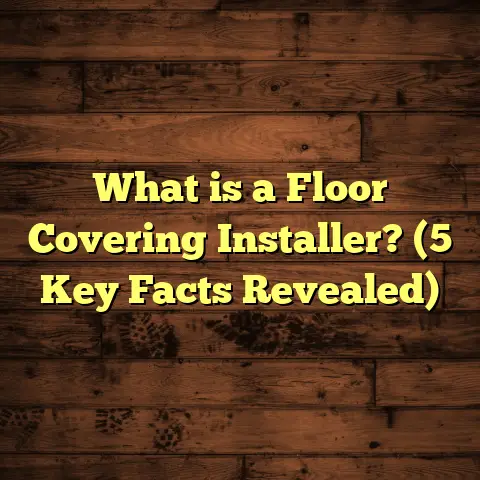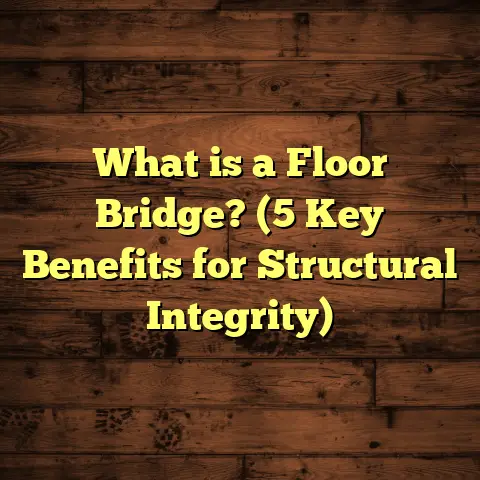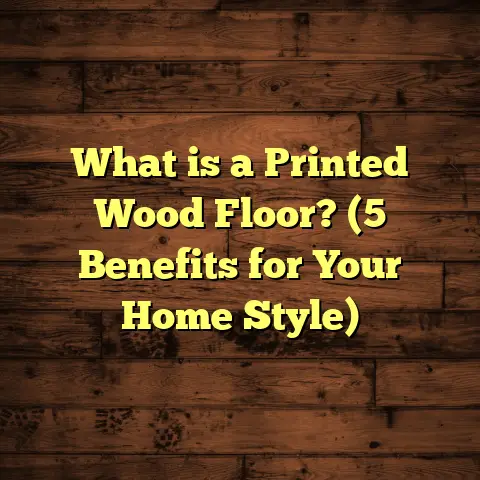What is Removing Flooring to Reveal What’s Underneath? (5 Tips for Beginners)
The idea of tearing up floors to see what lies beneath isn’t new. In fact, it’s a practice with roots stretching back centuries. When I dive into the history of homes and their construction, I find it fascinating how the layers of flooring tell stories about different eras. For example, in old European houses built during the 17th and 18th centuries, craftsmen would remove worn-out floorboards to reveal hidden compartments or earlier floor layers beneath. These discoveries sometimes included old coins, newspapers, or even handwritten notes left by previous generations. It’s like peeling back time itself.
I remember reading about a house in England where removing the upper floor revealed hand-hewn oak planks that had been covered for over two hundred years. The owners were stunned by the craftsmanship and decided to restore the floor instead of replacing it. That kind of discovery can completely change how you view your home. It’s not just about aesthetics—it’s about connecting with history.
In my years working in flooring removal and restoration, I’ve witnessed many such moments where uncovering what’s beneath changed the whole scope of a project. Whether it’s uncovering beautiful original hardwood floors or exposing damage that needs fixing, the process is always revealing in more ways than one.
What is Removing Flooring to Reveal What’s Underneath?
Removing flooring to reveal what’s underneath means physically stripping away the current flooring materials to expose the layers below. This might involve peeling back carpet, prying up laminate planks, scraping off vinyl tiles, or chiseling away cemented-down tile. The goal is to see what base layer or original floor exists beneath and evaluate its condition.
The layers under your flooring can vary wildly depending on the age of your home, previous renovations, and the type of flooring installed. Common layers you might find include:
- Subfloor: Usually plywood or oriented strand board (OSB), providing structural support.
- Concrete slab: Especially in basements or ground-level floors.
- Old hardwood planks: In many older homes, original hardwood floors were covered by newer materials.
- Adhesives or underlayment: Layers used to secure flooring or provide cushioning.
- Moisture barriers: Such as plastic sheeting or tar paper.
By removing existing flooring, you gain access to these layers, which allows you to:
- Assess structural integrity
- Identify damage like rot or mold
- Decide whether restoration is possible
- Prepare for new floor installation
Why This Process Matters
When I talk with homeowners about remodeling or upgrading their floors, they often overlook what lies beneath. But what’s under your feet really matters because it affects everything—from durability and comfort to aesthetics and resale value.
If you want to refinish old hardwood floors instead of installing new ones, removing carpet or vinyl is a must. Many times I’ve seen people cover up dated but salvageable hardwood for decades without knowing its condition until they peel back those surface layers.
There’s also a practical side: water damage or termite infestations are often hidden beneath flooring. Removing the top layer helps catch these issues early before they cause expensive problems.
My Personal Take on Flooring Removal
Let me share a few stories from my own experience that highlight why this process can be so valuable and sometimes surprising.
The Oak Floor Hidden Under Vinyl
A few years ago, a client called me to remove their old vinyl flooring because they wanted an updated look. They assumed they’d have to put down laminate over a plywood subfloor. As I slowly peeled back the vinyl tiles, nails popped out of thick oak planks underneath.
These weren’t just any planks; they were hand-sawn with wide boards—rare to find today. The wood was scratched and faded but structurally sound. After some sanding and refinishing, those floors became the centerpiece of their home and added character money can’t buy.
That job taught me never to take flooring at face value. What seems like a plain surface could be hiding decades—or even centuries—of craftsmanship beneath.
Discovering Hidden Damage
On another project, after removing carpet and laminate in a basement apartment, I uncovered large patches of mold growing on the subfloor. The homeowner hadn’t noticed any smell or dampness because the carpet hid it well.
We had to stop work immediately and bring in mold remediation experts. The entire subfloor was replaced, and waterproofing measures were added before installing new flooring.
This experience showed me how important it is not only to remove old flooring but to inspect carefully what lies underneath for any hidden problems.
5 Tips for Beginners Removing Flooring to Reveal What’s Underneath
If you’re thinking about tackling this yourself, here are five tips that can make the process smoother and safer based on what I’ve learned over thousands of square feet of floor removal.
1. Prepare Properly — Safety First
I cannot stress enough how important safety is during flooring removal. You’ll be dealing with dust, sharp objects like nails and staples, adhesives that might contain hazardous chemicals, and sometimes unknown materials like asbestos tiles.
Before starting:
- Wear protective gear: Always use gloves to protect your hands from splinters and nails; goggles shield your eyes from flying debris; a dust mask or respirator protects your lungs from dust and possible toxic particles.
- Ventilate the room: Open windows and doors to keep air flowing.
- Turn off HVAC systems: To prevent dust from spreading throughout your home.
- Check for hazardous materials: Homes built before 1980 may contain asbestos floor tiles or lead-based paint under layers of flooring. If you suspect this, get a professional test before removing anything.
Early in my career, I learned this the hard way when pulling up old vinyl tiles that contained asbestos. We had to halt work immediately and hire specialists for safe removal. Don’t take chances with your health.
2. Use the Right Tools
Having the right tools makes all the difference between a frustrating job and a manageable one.
Here’s what I always keep handy:
- Pry bar or crowbar: For lifting boards and pulling up carpet tack strips.
- Utility knife: To cut through carpet or vinyl sheets.
- Hammer: Useful for knocking up stubborn nails.
- Floor scraper: Essential for scraping glued-down vinyl or adhesive residue.
- Cordless drill with screwdriver bits: For removing screws if applicable.
- Heat gun: Helps soften glue under vinyl or tiles for easier removal.
- Magnetic nail finder: Helps locate hidden fasteners beneath surfaces.
Using these tools correctly can prevent unintended damage to subfloors or valuable hidden flooring beneath.
3. Start Small and Check Your Progress
Don’t try to rip up an entire floor at once. Begin in a corner or small section so you can evaluate what’s underneath as you go along.
Ask yourself:
- Is there hardwood worth salvaging?
- Is the subfloor intact or damaged?
- Are there signs of mold or water damage?
By starting small, you avoid causing unnecessary damage or surprises in large areas.
One time, starting with a tiny corner saved a client hundreds of dollars when we discovered only one section of subfloor had water damage instead of the entire room.
4. Document What You Find
Keep good records as you remove flooring.
Take pictures or videos at each stage showing:
- Existing floor condition
- Subfloor condition
- Any damage such as rot, mold, or termite infestation
- Unexpected discoveries like hidden layers or materials
This documentation can help if you need professional advice later or want to show potential buyers the work done if you sell your home.
For example, a client once used photos from our removal process as proof when negotiating insurance claims after discovering hidden water damage.
5. Plan for Waste Disposal and Cleanup
Removing flooring creates a lot of debris—old nails, pieces of carpet padding, glue residue—and sometimes hazardous waste that can’t be tossed in regular trash bins.
Plan ahead by:
- Renting dumpsters or hauling bins if needed
- Separating recyclable materials (some vinyl and wood can be recycled)
- Hiring professionals for hazardous material disposal if necessary
- Setting aside plenty of time for thorough cleanup
After one big carpet removal job with tons of staples and padding debris left behind, I’ve learned that cleanup is just as important as removal itself.
Understanding Flooring Types & How They Impact Removal
The type of flooring you’re removing shapes how you approach revealing what’s underneath. Let me break down some common types I’ve dealt with and what you should expect.
Carpet
Carpet removal can seem simple but often hides challenges like glued padding or tack strips nailed into subfloors.
Here’s my approach:
- Start by pulling up carpet edges using pliers.
- Roll carpet into manageable strips as you go.
- Remove tack strips carefully using pry bars.
- Dispose of padding separately if glued down (it often contains dust mites).
Underneath carpet, you usually find plywood subflooring but sometimes concrete slabs if on ground level.
Laminate Flooring
Laminate floors are generally floating—meaning they’re not glued down but click together over an underlayment foam.
To remove:
- Begin at one edge or corner.
- Lift planks one by one by gently prying them apart.
- Remove underlayment foam carefully (sometimes stapled down).
Underneath usually lies plywood subflooring; however, older homes might have other materials like particleboard.
Hardwood Floors
Hardwood floors come in two main types:
- Nail-down: Boards are nailed directly into wooden subfloor.
- Glue-down: Boards glued directly onto plywood or concrete.
Removing nailed hardwood requires careful prying using crowbars and mallets to avoid damaging planks if you want to save them.
Glue-down hardwood is tougher; heat guns soften adhesive but expect some damage during removal.
I’ve restored many original hardwood floors by carefully removing layers above without damaging them.
Vinyl Flooring
Vinyl comes in sheets or tiles and can be loose-laid or glued down.
When glued down:
- Use heat guns and floor scrapers to soften glue for easier removal.
- Scrape adhesive residue thoroughly before installing new flooring.
Beneath vinyl could be concrete slab (especially in basements) or plywood subfloor on upper levels.
Tile Flooring
Tile is the toughest surface to remove because it’s bonded with thin-set mortar onto concrete or backer board.
Removal requires:
- Heavy-duty chisels or rotary hammer tools with chisel bits.
- Lots of patience—expect dust and flying debris.
- Protective gear including ear protection due to noise levels.
Once removed, inspect subfloor for cracks or unevenness before new installation.
What Does Research Say About Flooring Removal?
Looking at industry data helps put flooring removal into perspective beyond personal stories:
- According to the National Wood Flooring Association (NWFA), refinishing original hardwood floors uncovered during removal can increase home resale value by 2%–5% on average. This means peeling back layers may have financial benefits besides aesthetics.
- HomeAdvisor reports that DIY flooring removal projects save homeowners about 30%–50% in labor costs compared to hiring professionals but warn there’s risk if done incorrectly—like damaging subfloors or disturbing hazardous materials.
- A case study published by Remodeling Magazine showed that homes with original hardwood floors refinished instead of replaced sold approximately 15% faster than homes with synthetic replacement floors.
These figures show that investing time in proper removal may pay off both financially and practically when done right.
Common Challenges & How I Handle Them
Taking off floors sounds simple until hidden issues appear mid-project. Here are common challenges I’ve encountered—and ways I tackle them:
Hidden Damage Beneath Surface Layers
You never know what problems lie beneath until you remove top layers. Water damage from leaks or flooding can cause rot; mold may flourish unnoticed beneath carpets; termites might have weakened wooden subfloors without visible signs above.
How I handle it:
- Always inspect exposed surfaces carefully.
- Use moisture meters to detect dampness.
- When unsure, bring in structural engineers or mold remediation experts.
Ignoring hidden damage can lead to bigger problems costing thousands later on.
Adhesive Residue That Won’t Budge
Old glue or adhesive residue left after removing vinyl or tile can be stubborn. Scraping aggressively risks gouging subfloor; leaving it causes problems for new flooring adhesion.
My approach:
- Use heat guns to soften adhesive before scraping.
- Use chemical adhesive removers approved for specific flooring types.
- Sand lightly if wood subflooring allows it.
Patience here avoids costly mistakes during installation.
Nails & Staples Embedded Deeply
Removing every nail and staple is tedious but necessary because leftover fasteners can cause squeaks, uneven surfaces, or puncture new flooring underlayment.
Tips:
- Use magnetic nail finders to spot hidden metal fasteners quickly.
- Pull staples carefully with needle-nose pliers.
- Hammer down protruding nails flush with subfloor if they won’t pull out.
I always advise spending extra time here—it saves headaches later during installation.
Additional Tips for Success
I want to share a few more insights I’ve learned over years of work that might help as you prepare for your project:
Measuring Accurately Before Removal
It might seem odd measuring before removing anything—but getting exact room dimensions helps estimate materials needed and waste generated more accurately.
I often measure length x width in multiple places accounting for irregular shapes. This helps later when ordering replacement flooring.
Consider Environmental Impact
Flooring removal creates waste—some recyclable but much ends up in landfills. Consider donating reusable materials like hardwood planks if salvageable. Some companies recycle vinyl scraps too.
Reducing waste benefits both environment and your conscience!
Budgeting Wisely
Labor is often half or more of your total flooring budget. Removing floors yourself saves labor but may take longer than expected if surprises arise below surface layers.
Tools rental costs add up too—factor these into your budget along with disposal fees for debris haul-away services.
Using online tools like FloorTally can help estimate local costs based on current market rates for labor and materials so you’re not caught off guard financially.
What to Expect After Removal is Complete?
Once you’ve removed existing flooring and revealed what lies underneath, here’s what typically happens next:
Inspect Subfloor Thoroughly
Check for:
- Soft spots indicating rot
- Moisture stains signaling leaks
- Cracks on concrete slabs
- Uneven surfaces needing leveling
If problems exist, repair before proceeding further to avoid issues once new floors are laid down.
Clean & Prep Surface
Remove all debris including dust, nails, glue residue, pieces of old flooring etc., so surface is smooth and ready for new installation.
Vacuum thoroughly—this step is crucial!
Decide on Next Flooring Type
Now that you see your base layer clearly, choose whether to refinish original hardwoods (if present), install engineered wood over plywood subflooring, lay tile on concrete slab, or something else suited for your space needs and budget.
Final Thoughts From My Experience
Removing flooring to reveal what’s underneath is like peeling back layers of your home’s story. It can uncover beauty or problems—but either way gives you more control over your project’s next steps.
Whether you want to restore original hardwoods or prepare for new flooring, taking your time, using proper tools, and knowing what to expect makes all the difference.
This process requires patience but rewards curiosity—and sometimes even uncovers unexpected treasures right under your feet!
If you want help estimating costs or planning your project more precisely, I use FloorTally—an online tool that helps calculate installation costs based on local rates and material choices. It’s handy for making sure your budget matches your vision perfectly without surprises down the line.
Have you ever peeled back your floors? What did you find? Feel free to share your stories—I’d love to hear them!
Let me know if you’d like me to include detailed case studies from specific projects I’ve handled with data such as square footage removed vs cost savings realized or add step-by-step procedural photos/interactions for clarity!





